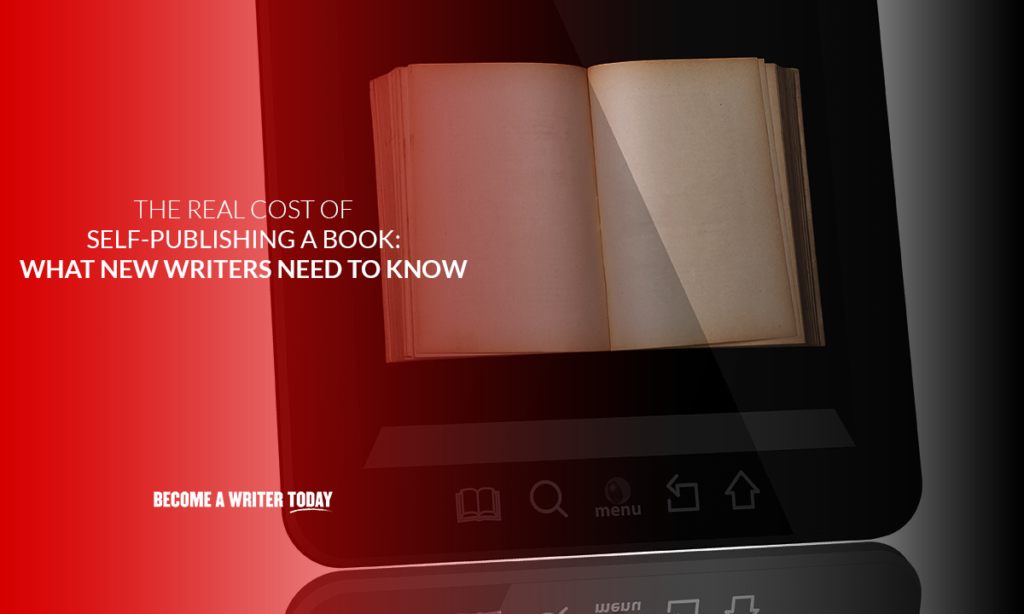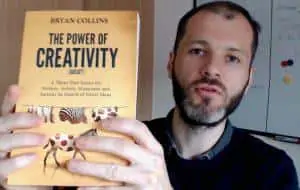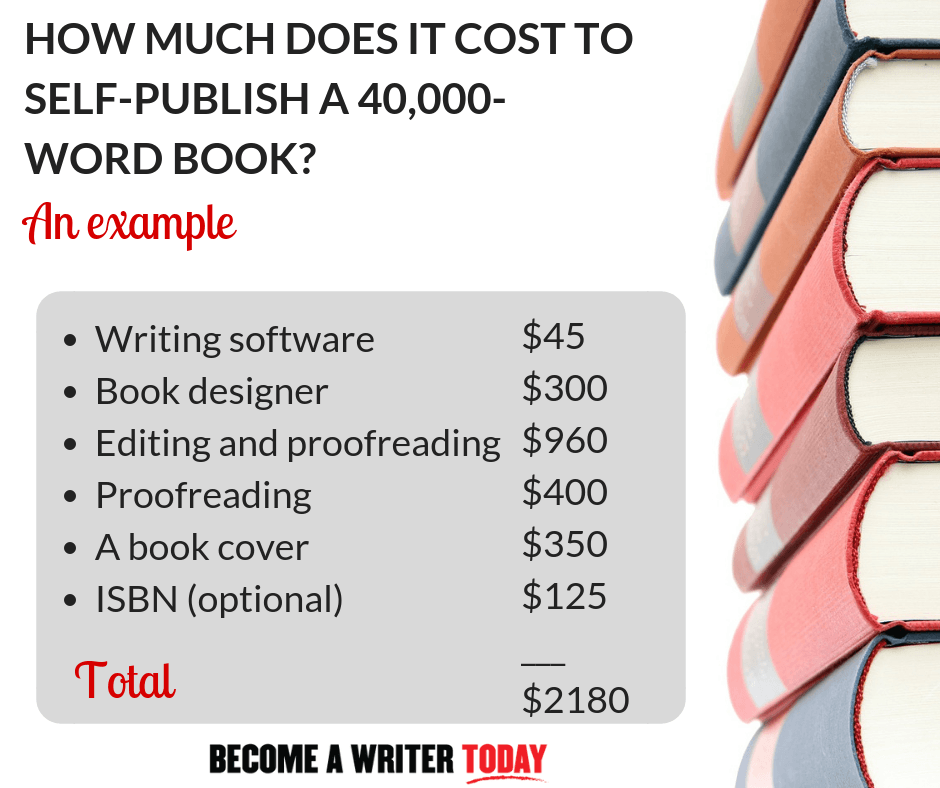The cost of self-publishing a book depends on the word count, required, cover art requirements and marketing.
It’s easier than ever to become an author thanks to platforms like Amazon, Kobo and IngramSpark. However, new writers considering self-publishing a book for the first time have lots of questions.
- How much will it cost to self-publish a book?
- What services will I need to pay for when publishing my first book?
- Should I commission a designer to create a professional book cover?
- What about book marketing and ads?
- Should I approach a traditional publisher?
- Can I use a self-publishing service to publish my first book?
These are a few of the questions I faced when I started self-publishing my books.
Royalty rates and making money from a book also concern new authors. After all, what writer doesn’t want to get paid for their hard work?
Now, if you think self-publishing a book is easy and free, think again.
Once you know how to write a book, you could prepare a digital book file, create a book cover in Paint, and upload it all to Amazon. This way, you could have a book for sale within hours of finishing it.
Then you could tell friends and family you’re a published author and share the link to your ebook retailer. But should you take this route for self-publishing a Kindle ebook?
The simple answer: No.
Why?
Professional authors take an effort to create and self-publish books readers love. They work with trained editors, proofreaders, and professional designers. Budgeting for your book is key to building a long-term career as a creative.
In this self-publishing guide, you’ll discover:
Contents
- The Publishing Industry:- A Quick Overview
- Traditional Publishers vs. Self-Publishing
- Why Self Publish a Book?
- How Much Does it Cost to Self-Publish a Book?
- 1. Self-Publishing Software
- 2. Editing and Proofreading
- 3. Book Cover Design
- 4. Book Formatting
- 5. Print
- 6. Audio
- 7. Book Marketing
- Pricing Your Book
- Do You Need an ISBN?
- The Cost of Self-Publishing: Final Word
- Cost of Self Publishing: FAQs
The Publishing Industry:- A Quick Overview

In the early 2000s, traditional publishers dominated the publishing industry.
They sifted through tens of thousands of manuscripts and chose one based on its ability to generate a return on investment.
In simple terms, publishers wanted a good return on the money they spent editing, proofreading, printing and marketing a book.
So they played it safe.
A book is a business investment, after all.
A new author with a manuscript had to catch publishers’ attention or work with an agent if they wanted to get their work published, never mind making money.
Unpredictable book sales and a market where publishers acted as gatekeepers to the writer’s audience presented big challenges for many creatives.
Even if you’re self-publishing, treat your book as a business investment.
Traditional Publishers vs. Self-Publishing
Here’s what happens in traditional publishing:
- You finish your manuscript
- You hire an agent (if you have the funds)
- You send your manuscript to publishers
- Your publisher markets your book on your behalf
If all goes well, your publisher might market your book, reach out to your target audience, reprint copies and so on.
That’s a big might.
Even then, the onus may fall on you, with your publisher only providing collateral.
In turn, you are entitled to a small amount of royalty money depending on negotiated royalty rates.
So making money from your book sales is not guaranteed.
Online self-publishing platforms like Amazon’s Kindle Direct Publishing, CreateSpace and IngramSpark mean you can use social media, advertising or email marketing to sell more copies. These platforms also provide audience reviews and book sales projections for users.
For many writers, self-publishing is a way of selling books online to reach a book sales target of more than a million copies and getting close to your audience.
The author can also control the entire process.
You can decide on the book cover, how many copies you want to sell and so on.
You can also maintain creative freedom over your story idea and other choices, like creating an online course based on your book.
What’s more?
With self-publishing, making money from your book is much easier if you’re prepared to learn about book marketing.
Royalty rates in self-publishing have skyrocketed, and you can earn up to 70% from each book!
So even if you are a new indie author, with the right marketing and by harnessing the benefits online retailers offer, you can sell hundreds, if not thousands, of copies.
Talk about a seller’s market.
Why Self Publish a Book?
If you write non-fiction, self-publishing a book will help you become build authority and earn more money. If you write fiction, a book will help you share your stories with readers and even realise a personal ambition.
But should you go the traditional route? Ask yourself these five simple questions:
- Do you genuinely believe in your story, even if publishers don’t?
- Do you know your audience?
- Do you see yourself as your book’s creative director, taking it from concept to completion and further?
- Do you want to see yourself making money from book sales?
- Do you have the resourcefulness to master online marketing?
If your answer is yes to any of these questions, you don’t need to think twice before choosing the self-publishing route.
So go ahead:
Freewrite your first draft. Identify your target audience. Find your ideal ebook retailer. And come up with an income target based on your book sales.
Now you can pursue your dream of becoming a successfully published author. If you’re interested in this topic, you might find our explainer on the pros and cons of self-publishing your book helpful.
How Much Does it Cost to Self-Publish a Book?
According to Reedsy, for every 1,000 words, authors can expect to pay an average of $24 for developmental editing, $15-20 for copy editing, and $10-$15 for proofreading. (Check out their average freelance editing rates.)
According to Book Promotion, more experienced writers spend several thousand dollars on self-publishing services.
Finally, Scott Allan explains on Self Publishing School that writers can spend less than $1,000 or up to $20,000.
I’ve spent less than $500 and more than $2,000 self-publishing different books. There are advantages and disadvantages to working on a shoestring budget and a larger budget.
The more you spend the better your book, but diminishing returns will set in at some point. If you’re sourcing a freelancer, for example, expect to pay a premium for a self-published book.

1. Self-Publishing Software
Budget: $100-$300
I’ll presume you already own or have access to a computer. But, you’ll need software like Google Docs, Microsoft Word or Scrivener.
- Google Docs is free to use.
- Scrivener costs $45.
- Word costs $45
- Vellum starts at $199
One of these tools or another writing app will help you write and edit the first draft.
What next?
2. Editing and Proofreading
Budget: $1000+
First up, the bad news: You’re too emotionally attached to your work to edit and proofread it. It’s always best if you enlist another pair of eyes to edit and format your book.
Most authors work with a development editor, a copy editor or line editor, and a proofreader. These professionals may charge by the word or per project.
- A development editor costs $17 per hour. A developmental edit of a 40,000 manuscript costs approximately $960.
- A copyeditor charges $15-20 per hour. Copyediting a 40,000-word manuscript costs approximately $680.
- A proofreader starts at $10-15 per hour. Proofing a 40,000-word manuscript costs approximately $400.
- Combining copyediting and proofreading works out at $680.
(Figures provided kindly by Reedsy)
Whoever you consider hiring, read their reviews and testimonials, so you can gauge the quality of their work beforehand. Rates vary widely, so shop around. The answer depends on how clean your draft is, your subject matter and what level and quality of editorial support you want.
If you want to save money, Emmanuel Nataf, CEO of Reedsy told me:
“Make sure you’ve already edited it as best as you can yourself. That means removing sections you know won’t make the final edit and taking a pass to correct the spelling, grammar, and punctuation. You do not want to pay professional rates for something that Microsoft Word already does for free.”
A developmental editor will provide critical feedback about your book’s tone and direction in a reader’s report. They may offer light copyediting, depending on your contract.
A copy editor or line editor will go through each sentence and polish them. The editor will also check that your spelling, word choice and the overall style of your book is consistent. They’re kind of like a copywriter.
A proofreader will eliminate typos and grammar mistakes and might also look for factual inaccuracies.
Working with Your Editor
While self-publishing my first book, I hired a proofreader, but I didn’t hire an editor. Having worked as a journalist and sub-editor, I felt confident about editing a non-fiction book myself.
That wasn’t my only mistake.
I hired a cheap proofreader for $200 to check my first book. This proofreader found some errors (but not all of them) before I self-published it. After I uploaded the first version of my book, I found some additional errors and typos (the shame!).
After a reader complained to me about some more typos, I rained furious hellfire down upon him. When that didn’t work, I used the online proofreading service Grammarly to recheck every chapter. Then I resent this book to a professional proofreader for $300.
A month later, I uploaded a new version to Amazon. I also paid to have much of the book re-edited. I also retitled and redesigned the cover of the book so I could position it to the right readers more effectively and increase sales.
For every book I’ve self-published since 2014, I’ve worked with an editor, proofreader, and occasionally a line editor.

Tips for Hiring an Editor or Proofreader
Typically, an editor will send you a reader report with an annotated version of your manuscript. The proofreader and line editor also make changes in a document and send it back to you to accept or reject.
Feedback like this, while sometimes tough, will improve the quality of your book and teach you more about writing (a nice added bonus).
Now, you can hire an editor, proofreader and copy editor based on:
- Your total word count
- The hours you want the editor/proofreader to spend on your book
- Your total page count
- Your project as a whole
Before hiring an editor or proofreader, ask them:
- What style they’ll use. The Chicago Manual of Style is pretty popular.
- Will they edit your book in British or US English?
- Can they provide a sample edit for you to review (usually free)?
- Do they specialize in any genre?
- Can they provide testimonials from satisfied clients?
- How long will an edit take?
- What are their rates?
Editing On A Budget
If you can’t afford an editor or proofreader, start saving! Working with an editor is the single best way to improve your book and your craft. That said:
If your close friend or another writer offers to help with editing and formatting the book, and they know what they’re doing, take them up on their offer until you can afford to hire a professional.
Several years ago, I was a member of non-fiction writing group. Each of us critiqued and edited the works of others in the group. So that’s a worthwhile option if you’re on a tight budget.
Similarly, if you write guest blog posts based on your draft, you can get free editorial feedback about your non-fiction. After your guest post goes live, you can always reuse elements of the post as chapters in your book with some light rewriting.
I caution against self-publishing your book without hiring or getting an eagle-eyed friend to proofread your book.
Those typos will come back to haunt you.
3. Book Cover Design
Budget: $200-$500+
Hiring the services of a professional book cover designer is one of your top priorities before self-publishing your book. It costs $500 or more to hire a good book cover designer, and like hiring an editor, you get what you pay for. Competitions on crowdsourcing websites like 99designs start at $240.
That’s a lot but a good cover is your book’s best chance of standing out against the hundreds of thousands of others on stores like Amazon.
When I started out, I stayed up till 2:00 a.m. for nights on end taking online design tutorials.
I created a book cover that had almost nothing to do with the contents of my book (above), which I didn’t use in the end. I also spent time designing that I should have spent on my book. Since then, I’ve run competitions on sites like 99designs and worked directly with book cover designers.
As a writer, your time is better spent writing than tinkering in Photoshop or Illustrator. So either start saving or reframe the expense as an investment in your craft.
Still not convinced? Here’s what Nata, CEO of Reedsy said:
“We ran an experiment to see how a professionally-designed cover would affect its salability.
Our designers rebranded a number of books with self-made covers and A/B tested the original designs with our new ones to see which would better appeal to fans of their genre.
In some cases, we saw a click-through rate increase of more than 50% — which, in marketing terms, is an awful lot.”
How to Hire a Book Cover Designer

It’s relatively easy to find a professional book cover designer. I found one to design my book cover for The Power of Creativity.
Joel Friedlander and the team at The Book Designer run a monthly competition that showcases some of the best indie book covers.
Just browse the categories and reach out to the designer you like who has experience creating book covers in your niche.
Then you’ll need to determine if he or she is free to work on your cover and come to an agreement on price and deliverables.
Some budget-friendly designers will let you pick from book cover templates. More expensive designers will create something unique for you.
Before you engage your designer, let them know if you want an ebook cover, print cover and a 3D mockup for your author website.
These extras cost more. Also, insist on the source files, which is the Photoshop or Illustrator files and not just the book cover image.
1. Decide Your Budget
You can spend a lot or a little on your book cover. If you spend a modest amount (less than $100), you’ll probably have to pick from pre-designed templates. If you spend more, you can work one-on-one with a designer.
2. Research Your Niche
The covers of thriller books look different from the covers of self-help books. The former relies on dark imagery, while the latter relies on hopeful imagery.
So spend at least an hour browsing stores like Amazon and saving book covers in your niche that you like. (Pinterest and Evernote are both good for this.)
3. Write a Design Brief
- Are you okay with stock imagery?
- Do you prefer simple designs, or do you have an image in mind?
- Do particular colors and fonts resonate with you?
If your writing draws on key imagery or metaphors, let your designer know, as they could work an element into your cover. Include a sample chapter for them to read too.
Providing this information will reduce the amount of time both of you spend debating a design later.
4. Give Proactive Feedback
Depending on how much you pay, your designer will go through one or two rounds of changes with you. Tell them what you like and dislike about the cover and what you want to be changed.
Remember, your book cover needs to look good at small sizes so it stands out in digital bookstores.
But what if you don’t know what you like? Ask a friend or your early readers for their opinions about the book cover. They might have a good eye for design or captivating images.
How to Crowdsource Your Book Cover
Sites like 99designs, CrowdSpring and DesignCrowd enable you to run competitions. If you host one, designers will submit covers for you to review. When you pick the best one, the winner gets a prize that you front.
I used 99designs in the past for a book cover, and I was happy with the results. Several years ago, I wrote an article about my experiences, and you can see some of the cover submissions.
Some unhappy designers complained in the comments about crowdsourcing websites. They argued losers get nothing for their submission or hard-work.
If you decide on this approach, you’ll still need to brief your designer and work with the winner to finalize it.
Book Cover Design on a Budget
Yes, you could design a cover yourself in Paint or Photoshop or buy a cheap cover for a couple of dollars on a site like Fiverr. You could also rub lemons in your eyes, but that doesn’t mean you should.
Unless you’ve got ace design skills, please don’t—a cheap cover screams cheap writing.
If you can’t afford to hire a designer, Canva provides a series of free ebook cover templates you can adapt. Later on, you can always swap this cover for a more professional design.
There’s no cheap shortcut to preparing a book for print, unfortunately.
You can always prepare your book file using Vellum (Mac only), but you’ll need a designer’s help to get the cover right for print. If that’s an issue, publish a digital copy of your book first and a print copy later on.
If you want to learn more, read our complete guide to working with a book cover designer.
4. Book Formatting
Cost: $150+
Formatting a book is relatively easy these days, thanks to Vellum. You can import a Word document and adjust the visual look and feel of your book quickly and easily. It took me about an hour for format a 40,000-word ebook in Vellum. However, this software is Mac only.
If you’d rather not use Vellum, Scrivener can also format a book for publication. However, it has a steep learning curve. While I love Scrivener for long-form works, it isn’t as intuitive for book formatting.
Your other option is to hire a book designer. Typically, a book designer will use Adobe Indesign. Expect to pay them between $150 and $200. Remember, to ask them for the book source files so you can make changes with another designer later if needed.
5. Print

Budget: $149+
What writer doesn’t want to hold their book in their hands? If you follow the guidelines on Amazon, you can do just that. Vellum (Mac only at the time of writing.) also enables writers to compile a print version of their books.
It costs $250-$300 to hire a designer to prepare a 40,000- to 50,000-word book for print. I expect this cost to fall as self-publishing software becomes easier to use. At the time of writing, Vellum Press (for creating print books) costs $249.
If you can’t or don’t want to use Vellum, hire a designer to prepare your print book. They will take care of headaches like laying out each page correctly.
They also will check that your cover is the right depth, break up run-on sentences and so on. A good one will also take care of single words at the top of a page or the last line of a chapter at the top of a page.
Again, expect to pay them $150+ depending on the length of your book.
6. Audio
Budget: $1000+
Creating an audiobook is a project in itself. In this guide, I cover how to make an audiobook. You have several options. Firstly, record and edit the audio yourself. That’s assuming you have the equipment and technical skills.
Secondly, record the audio and hire an audiobook editor. Expect to pay at least $250+ for four hours of edited audio.
Thirdly, use a service like Audible ACX or Findaway Voices. Prices start at $1000, depending on the contract you negotiate with your book narrator and editor.
If you haven’t recorded and edited an audiobook before, it takes a lot of trial and error. And you’ll still need a good microphone and audio editing software.
Despite the cost, the third option is the easiest for most new authors. If money is an issue, consider using book sales royalties from your ebook to invest in an audiobook later.
7. Book Marketing
Budget: Unlimited
First up, the bad news:
The ebook market is crowded with substandard books. You’ve got to stand out from the noise if you want to make money self-publishing a book.
Inviting friends and family, a few loyal fans, and maybe a reporter or two from the local newspaper won’t help you sell many copies either.
To stand out from the tens of thousands of books and ensure your book’s success, you need to launch a book and plan to market it.
That means budgeting for advertising and promoting your book over email by giving away some free copies. Thanks to online retailers like Amazon, the concept of “book launch” has taken a new meaning. Basically, self-published authors must also plan to market and sell their book once live on stores like Amazon.
I typically spend about $500 per month on advertising new books using Amazon Ads. Many indies spend a lot more using Facebook and Bookbub ads.
You can also use paid book promotion services like Bookzio ($25) and Robin Reads ($60). Many other book promotion services exist, although they are mostly geared towards genre fiction.
Here are a few tips you should keep in mind while launching your book with an online retailer:
- Give your book away for free to early or beta readers.
- Use their feedback to improve your book and fix any typos or formatting issues.
- Collect positive reviews from beta readers and ask them to publish their reviews when you launch.
- Email your list when your book comes out.
- If your book is non-fiction, promote it by writing guest posts.
- Invest in Amazon ads to promote your book.
- Use Kindle Direct Publishing – KDP Select Program if it’s your first book.
A Brief Guide to the KDP Select Program
When you choose this program, unlike the conventional Kindle Direct Publishing, you give Amazon the exclusive rights to sell your books for 90 days, and the rights automatically renew.
This service is free to use, although Amazon takes a cut of your royalties.
The KDP Select Program might seem too restrictive for new writers who want to take over the charts. That said, KDP Select will boost your book marketing process by giving you five “free promotion” days.
During “free promotion” days, offer your book for download at no cost. The Amazon algorithm might put your book in the “Recommendations” section even after your book switches to paid.
What’s more, if you manage to get your book on the same Amazon sales page as a traditional best-selling author, you will sell even more copies.
At the very least, you will get your book in front of more readers and potentially collect organic books reviews. These will improve the quality of your book’s sales page. That can mean only one thing—more success for your book.
Finally, readers love a back catalogue.
The Amazon algorithm will recommend your older or newer books to readers. When in doubt, remember: The best way to market your last book is to write the next one.
Pricing Your Book
This is one of the key aspects you have to think about after you have completed writing, editing and formatting your book.
The price of your book plays a crucial role in your book’s success.
Price the book too high, and you can put potential readers off. Price your book too low, and you’ll leave money on the table.
Your book’s success depends on finding the sweet middle spot. So, don’t be afraid to experiment.
For example, I charge more for print copies of my books than for digital copies. People don’t mind paying a few extra dollars for an indie author’s book if it’s well-written and professional.
However, if readers find mistakes or you’ve priced the book too high, expect negative reviews from the same people.
The average self-published book sells approximately 250 copies over its lifetime, according to both Science Fiction and Fantasy Writers of America and the Nonfiction Authors Association.
That said, you can sell many more copies on an ebook retailer like the Amazon Kindle store if you take book marketing seriously and invest in ads and grow an email list of loyal readers.
Let’s look at the math:
- Amazon gives you 35% of the price of every book sold for $2.98 or under and up to 70% for every book priced between $2.99 and $9.99.
- If you sell a thousand copies of a book for $9.99 in year one, that means you’ll earn up to $7,000 for one book.
- If you self-publish multiple versions of your book (Kindle, print, large print audio, etc.) this is achievable.
Over the past year, I’ve watched revenue from audiobooks and print books increase. Now, these formats account for 40% of revenue generated from my book sales.
Find out how to make an audiobook… and how much that costs.
Do You Need an ISBN?
Amazon assigns an international standard book number for your print or Kindle book automatically. You don’t need to one self-publish your first book on Amazon.
That said, buying an ISBN will help you establish ownership of your book across multiple stores and get your book into libraries, universities and more.
You can buy a ten pack of ISBN from a reputable provider like Bowker for approximately $125 and assign one to your book. This is advisable if you intend to publish a print book and retain your rights or want to publish your book on IngramSpark.
Beware of buying ISBNS in bulk from self-publishing companies.
They will be recognised as the publisher instead of you. This complicates re-publishing the book under your own ISBN and retaining full rights.
Read more about ISBNs here and here

The Cost of Self-Publishing: Final Word
It’s not easy, but this route offers full creative control over the process, and you could even earn more money in the long-run.
First, though, you need funds to create and self-publish a book that sells.
Each time I self-published a book, I hired more expensive editors, designers and so on to improve the quality of the books. I also spent money on marketing my books via Facebook and Amazon ads.
The more I spent on my books, the more money I earned.
Look…
You can spend as much or as little as you want self-publishing your non-fiction book.
If you invest a little money, you’ll break even on the cost of your book faster. But if you invest more, you’ll create a better product and improve your craft with professionals’ help.
Unlike years ago, you control the process (including the budget), and that’s a liberating place to be for most indies.
Now, one question remains:
Are you ready to become an author?
Cost of Self Publishing: FAQs
How much does it cost to self publish a book on Amazon?
Technically, it’s free to use and self-publish a book on Amazon. However, you still need to budget for writing software, editing, formatting and a book cover. Expect to pay at least $2000+ on creating a professional book. Promoting your book on Amazon via ads can cost several hundred dollars per month.
Is Amazon Self Publishing worth it?
Amazon self-publishing is worth it if you’re committed to building a career as an author and enjoy working with the written word. It’s a great way of reaching readers around the world with Kindle and print books. However, think beyond Amazon. You can also sell on Kobo, IngramSpark and Apple Books.
